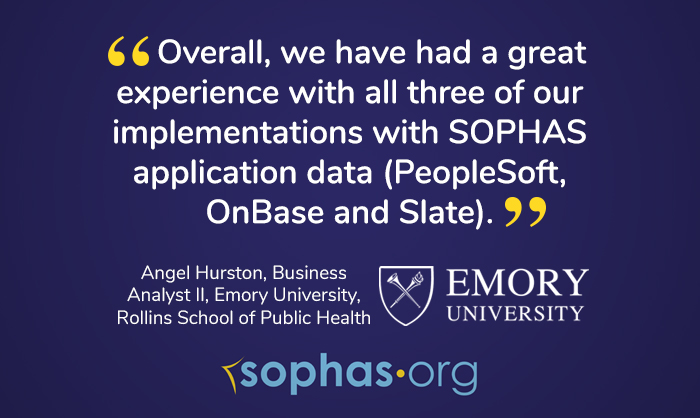What’s it like to use a Centralized Application Service (CAS™) with your existing on-campus systems? Angel Hurston, business analyst II, recently shared her experience at the Emory University Rollins School of Public Health.
“The Rollins School of Public Health at Emory University implemented the SOPHAS™ application review process during its first cycle in 2006, which included integration with PeopleSoft Student Administration. We used our existing PeopleSoft application staging tables and load process to map the SOPHAS fields to corresponding PeopleSoft fields. This load included all application data (bio/demo, SSN, test scores, schools attended, employers, etc.).
SOPHAS field values were mapped and converted to the PeopleSoft field values using a translate table. At that time, the application review process was completed using a paper application file. Rollins implemented OnBase for online application review in 2013, which involved importing the SOPHAS full application PDF into OnBase. A second import of the full application PDF was used to parse the PDF into specific application materials (references, personal statements, resumes, etc.).
In 2016, Rollins implemented Slate, which included imports for all SOPHAS application data, the full application PDF and most of the individual application materials. The application data is exported from WebAdMIT each week and imported into Slate. Then, the application data is exported from Slate and imported into PeopleSoft which is Emory’s system of record. After the application data is loaded into PeopleSoft, we export the unique PeopleSoft ID/application number and import it back into Slate using the SOPHAS ID. This allows us to import decisions from Slate to PeopleSoft.
Overall, we have had a great experience with all three of our implementations with SOPHAS application data (PeopleSoft, OnBase and Slate). Having the Custom Export Layout files made it easy for us to determine which fields required translate values. With the Slate implementation, we were able to add fields to capture SOPHAS/organization-specific data and include PeopleSoft values in the export file that would translate to the PeopleSoft values. We collect additional data that is specific to Emory and having the custom fields has allowed us to collect the data with the application, eliminating the need to follow up with applicants later in the application process.”
